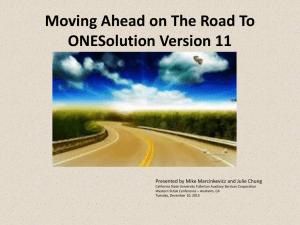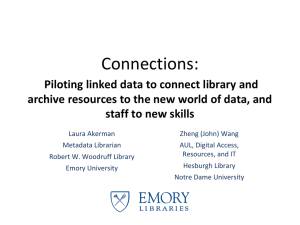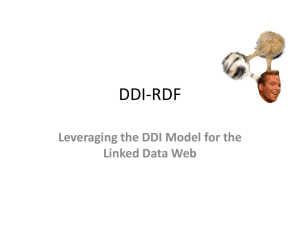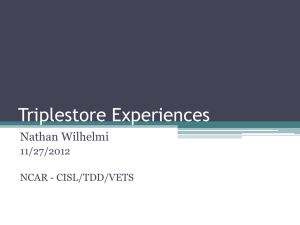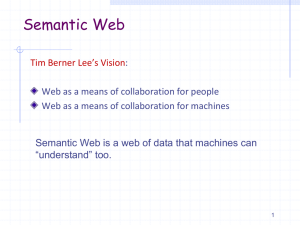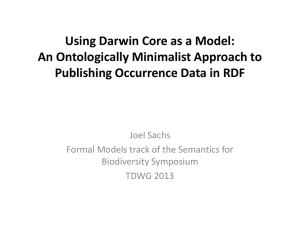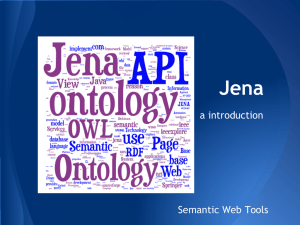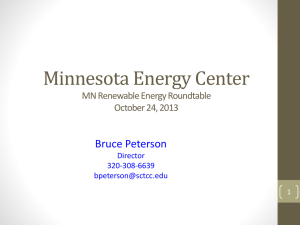OIL: Ontology Inference and Interchange - On-To
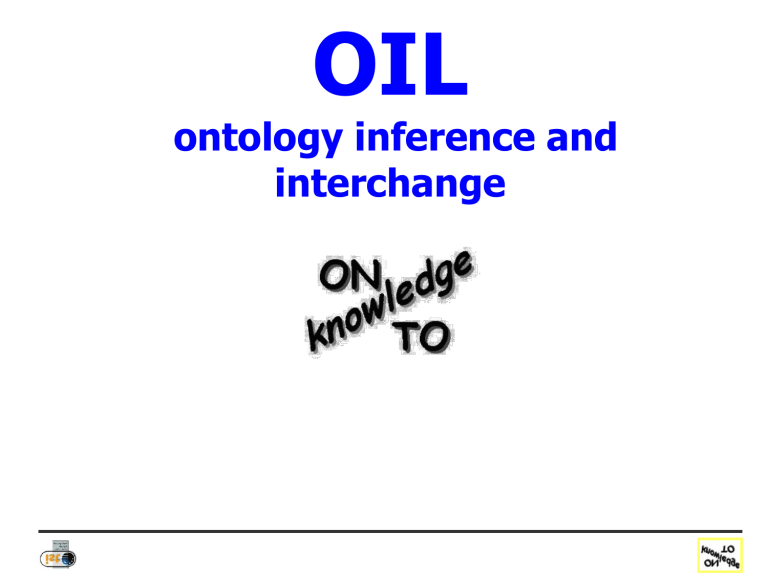
OIL
ontology inference and interchange
Topics for this presentation
OIL as a common core language
(4)
aspects of OIL
(5)
OIL on the Web
Why XML is not enough
Why RDF(S) is not enough
OIL as RDF(S) extension
(3)
(9)
(3)
WP1 results & plans
(4)
On-To-Knowledge 2
Remember:
Ontologies are crucial for KM
• “ consensual and formal specifications of conceptualisations ”
• provide a “ shared understanding of a domain for communication across people and systems ”
On-To-Knowledge 3
Place in the project
WP 1:
tools for ontology construction and interchange foundational to all three layers of
On-To-Knowledge architecture
WP1.1
= ontology language
Partners = VU + AIdministrator
Deliverable 1 = ontology language version 1 user repository source info
Requirements for a common core
Ontology-language
Well defined syntax (pretty obvious)
read ontologies
Well defined semantics
often overlooked but equally important process (“understand”) ontologies
Expressive enough
to capture many ontologies
Easy mapping
to/from other ontology languages
Efficient reasoning support
Why Reasoning Support?
Reasoning support is key feature of OIL-core
Important
as design support tool for large ontologies with multiple authors for integrating and sharing ontologies
Because it allows to
Establish inter-ontology relationships
Check for consistency
Check for (unexpected) implied relationships
Shown useful for DB schema integration
Ingredients for a common core
Frame Based Languages
intuitive for many users
Extensive set of modelling primitives
OKBC, OKBC-lite, XOL
(Description) Logic-based languages
negation and disjunction (e.g disjointness) properties for slots/relations
• e.g. transitivity for contained-in
Formal semantics
Reasoning support
• inconsistency-detection, implicit superclass-detection
Proposed common core: OIL
Based on standard frame languages (OKBC)
restricts & extends
Has both XML and RDF(S) based syntax
formalised by DL style logical constructs
Still has frame “look and feel”
Can still function as a basic frame language
OIL core language restricted to allow:
reasoning support
No constructs with ill defined semantics
DL
OIL
WWW Frames
On-To-Knowledge 8
OIL: Restricts Frame Languages
No defaults
limited axioms/rules
only definition of ontology (not individuals)
Main reasons for this :
Reasoning support
Semantics
DL
OIL
WWW Frames
On-To-Knowledge 9
OIL: Extends Frame Languages
Classes can be primitive (nec. conditions)
elephant
animal that has-colour grey
or defined (nec. and sufficient conditions)
vegetarian
person who eats meat nor fish
Classes allowed in slot constraints
slot-constraint eats has-value meat
(eats some meat) slot-constraint eats value-type meat
(eats only meat)
DL
OIL
WWW Frames
On-To-Knowledge 10
OIL: Extends Frame Languages
Can use arbitrary class expressions instead of only class names
slot-constraint eats value-type NOT ( OR meat fish)
Cardinality constraints can include value-types
slot-constraint eats max-cardinality 1 plant
Supports sub-slot relation
daughter-of sub-slot of child-of
Slot properties
transitive (e.g., part-of )
symmetrical (e.g., connected-to)
DL
OIL
WWW Frames
OIL has a Formal semantics
Defined by mapping to very expressive DL
slot-constraint eats has-value meat, fish
=
eats:meat
eats:fish
Mapping is used to provide reasoning support from a DL system
(e.g., FaCT)
DL
OIL
WWW Frames
On-To-Knowledge 12
OIL (explained by example)
class-def animal
class-def plant subclass-of NOT animal
class-def tree
subclass-of plant
class-def branch
slot-constraint is-part-of has-value tree
% animals are a class
% plants are a class
% that is disjoint from animals
% trees are a type of plants
% branches are parts of some tree max-cardinality 1
class-def defined carnivore
subclass-of animal
slot-constraint eats
% carnivores are animals
% that eat any other animals value-type animal
class-def defined herbivore % herbivores are animals
subclass-of animal, NOT carnivore % that are not carnivores, and
slot-constraint eats % they eat plants or parts of plants value-type plant OR (slot-constraint is-part-of has-value plant)
How to put ontologies on the Web
(internet, intranet, extranet)
The W3C hierarchy of languages:
Declarative Languages
(OIL, DAML-O)
HTML
On-To-Knowledge
XHTML SMIL
XML
DC PICS
RDF(S)
14
XML: Document = labelled tree
• node = label + attr/values + contents course
<course date= “...” >
<title> ...
</title>
<teacher> ...
</teacher>
<name>...</name>
<http>...</http>
<students> ...
</students>
</course> title teacher students name http
• DTD : simple grammars to describe legal trees
• So: why not use XML to represent ontologies ?
On-To-Knowledge 15
XML: limitations for semantic markup
XML makes no commitment on:
Domain specific ontological vocabulary
Ontological modelling primitives
requires pre-arranged agreement on &
Only feasible for closed collaboration
agents in a small & stable community pages on a small & stable intranet not for sharable Web-resources
On-To-Knowledge 16
Remember the W3C vision
HTML
On-To-Knowledge
Declarative Languages
OIL
XHTML SMIL
XML
DC PIC
RDF(S)
17
RDF(S): general background
Intended for representation “meta-data”, basis for Web-based ontology-language
W3C recommendation
“Because it’s there”:
pushed hard by W3C (TBL Himself)
basis of $ 80M DAML program
Already embraced by some vendors
(Netscape)
On-To-Knowledge 18
Bluffer’s guide to RDF (1)
Object --Attribute-> Value triples
Author-of pers05 ISBN...
objects are web-resources
Value is again an Object:
triples can be linked
data-model = graph
Author-of pers05 ISBN...
Publby
MIT
ISBN...
On-To-Knowledge 19
Bluffer’s guide to RDF (2)
Object --Attribute-> Value triples objects are web-resources
triples can be linked data-model = graph
Any statement can be an object
graphs can be nested claims
NYT pers05
Author-of
ISBN...
On-To-Knowledge 20
Bluffer’s guide to RDF Schema
So, RDF :
(very small) commitment to modelling primitives but: no commitment to domain vocabulary
RDF Schema
Define vocabulary for RDF
Organise this vocabulary in a typed hierarchy
Class, SubClassOf, type
Property, subPropertyOf,
domain, range
On-To-Knowledge 21
Bluffer’s guide to RDF(S)
RDF
Statement = Object - Attribute -Value triple
Values can be objects ( chaining )
Statements can be objects ( reification )
RDF Schema
Define domain-specific vocabulary for OAV’s
Type-hierarchy for this vocabulary using
Class, SubClassOf, type
Property, subPropertyOf, domain, range
RDF Schema syntax in XML
<rdf:Description ID=" MotorVehicle ">
<rdf:type resource="http://www.w3.org/...# Class "/>
<rdfs:subClassOf rdf:resource="http://www.w3.org/...#Resource"/>
</rdf:Description>
<rdf:Description ID=" Truck ">
<rdf:type resource="http://www.w3.org/...# Class "/>
<rdfs: subClassOf rdf:resource="# MotorVehicle "/>
</rdf:Description>
<rdf:Description ID=" registeredTo ">
<rdf:type resource="http://www.w3.org/...# Property "/>
<rdfs: domain rdf:resource="# MotorVehicle "/>
<rdfs: range rdf:resource="# Person "/>
</rdf:Description>
<rdf:Description ID=” ownedBy ">
<rdf:type resource="http://www.w3.org/...# Property "/>
<rdfs: subPropertyOf rdf:resource="# registeredTo "/>
</rdf:Description>
State-of-the-art@W3C
RDF: to represent “meta-data”
RDF-S: to define vocabulary for RDF
RDF is data-model + syntax
only a very weak semantic interpretation no inference model
RDF-S goes a step further, but still
no precisely described meaning no inference model
On-To-Knowledge 24
Quote from Ora Lassila (RDF)
Future: We Need More!
Structural modeling obviously not enough
we need a “logic layer” on top of RDF
some type of description logic is a possibility (after all, we are talking about frame systems )
Exposing a wide variety of data sources as RDF is useful, particularly if we have logic/rules which allow us to draw inference from this data
My proposal: RDF + DL = “Frame System for WWW”
this is probably a good starting point for DAML as well
(details to be worked out by this workshop )
Quote from Henry Thompson
“The Semantic Web needs a logic on top”
NB: “a” logic = the box with the crank
FOL
OIL = modelling primitives from frames (OKBC-lite)
+ semantics and inference from Description Logic
+ syntax from RDF(S) & XML(S)
DL
OIL
WWW Frames
On-To-Knowledge 26
OIL for the Semantic Web
Declarative Languages
OIL, DAML-O
HTML
On-To-Knowledge
XHTML SMIL
XML
DC PIC
RDF
DL
OIL
WWW Frames
27
OIL as RDF(S) extension
(1/2)
< rdfs:Class rdf:ID=” herbivore ”>
< rdf:type rdf:resource=” http://www.ontoknowledge.org
/# DefinedClass ”/>
< rdfs:subClassOf rdf:resource=”# animal ”/>
< rdfs:subClassOf >
< oil:NOT >
<oil:hasOperand rdf:resource=”# carnivore ”/>
</oil:NOT>
</rdfs:subClassOf>
</rdfs:Class>
On-To-Knowledge 28
OIL as RDF(S) extension
(2/2)
• class-def
• subclass-of
• slot-def
• subslot-of
• domain
• range
RDF(S)
OIL
• class-expressions
• AND, OR, NOT
• slot-constraints
• has-value, value-type
• cardinality
• slot-properties
• trans, symm
OIL as the basis for DAML-O
DAML = $80M DARPA program for
Semantic Web
Ontologies are regarded as fundamental
first version of DAML-O out < end 2000
mandatory use for all DAML participants
(W3C, Stanford, ISI, Lockheed, MIT, Nokia,...)
OIL is used as the basis for DAML-O
On-To-Knowledge 31
WP1: Results
(1/2)
Definition of language
semantics
XML encoding
RDF encoding
10 publications
EKAW, ECAI-WS, IEEE-IC, DL, KRDB, eBeW
already take-up in work by others
• Madrid, Bremen, IBROW, Boeing,Daimler-Chrysler,...
collaboration with DAML
On-To-Knowledge 32
WP1: results
(2/2)
translators (Java, XSL-based):
XML OIL FaCT
XML OIL RDFS OIL
case-studies
GIS ontology mapping
(KA)
2 ontology
CIA world fact book
On-To-Knowledge 33
OIL: currently available tools
Definition of language
semantics
XML encoding
RDF encoding
Tools:
translators (XSL based) reasoner (FaCT, DL-based)
OntoEdit, OILed
case-studies
GIS ontology mapping
(KA)
2 ontology
CIA world fact book
OIL: some collaborating parties
EU academics
University of Bremen
Univ. of A’dam
OU-UK
Univ. Manchester
A’dam Medical Centre
US academics:
Univ. of Stanford (DB, KSL, Med.Inf)
Univ. of Maryland
SRI
outside academia
W3C (RDF Working group)
DARPA (DAML initiative) EU IST Projects
IBROW
Comma
C-Web
Industrials:
Boeing
Daimler-Chrysler
Interprice
On-To-Knowledge 35
OIL: current & future work
Layered approach to anguage extensions
RDF(S)
OIL-lite
Standard OIL
OIL layer 1
...
axioms, concrete domains, modules, defaults,...
Ontology construction
Ontology evolution
Ontology mapping
On-To-Knowledge 36
